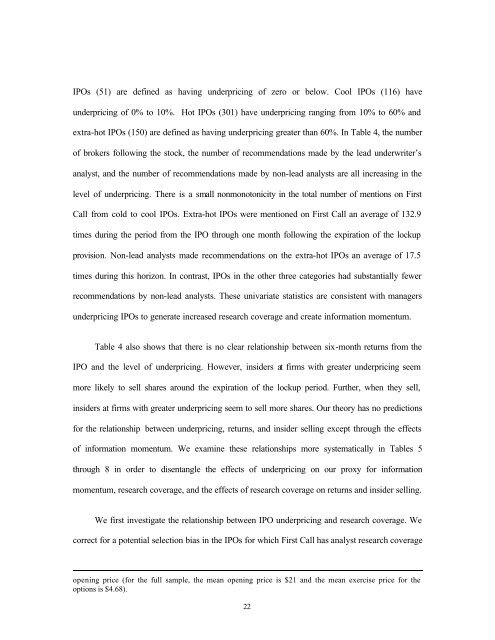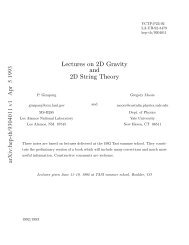Strategic IPO underpricing, information momentum, and lockup ...
Strategic IPO underpricing, information momentum, and lockup ...
Strategic IPO underpricing, information momentum, and lockup ...
Create successful ePaper yourself
Turn your PDF publications into a flip-book with our unique Google optimized e-Paper software.
<strong>IPO</strong>s (51) are defined as having <strong>underpricing</strong> of zero or below. Cool <strong>IPO</strong>s (116) have<br />
<strong>underpricing</strong> of 0% to 10%. Hot <strong>IPO</strong>s (301) have <strong>underpricing</strong> ranging from 10% to 60% <strong>and</strong><br />
extra-hot <strong>IPO</strong>s (150) are defined as having <strong>underpricing</strong> greater than 60%. In Table 4, the number<br />
of brokers following the stock, the number of recommendations made by the lead underwriter’s<br />
analyst, <strong>and</strong> the number of recommendations made by non-lead analysts are all increasing in the<br />
level of <strong>underpricing</strong>. There is a small nonmonotonicity in the total number of mentions on First<br />
Call from cold to cool <strong>IPO</strong>s. Extra-hot <strong>IPO</strong>s were mentioned on First Call an average of 132.9<br />
times during the period from the <strong>IPO</strong> through one month following the expiration of the <strong>lockup</strong><br />
provision. Non-lead analysts made recommendations on the extra-hot <strong>IPO</strong>s an average of 17.5<br />
times during this horizon. In contrast, <strong>IPO</strong>s in the other three categories had substantially fewer<br />
recommendations by non-lead analysts. These univariate statistics are consistent with managers<br />
<strong>underpricing</strong> <strong>IPO</strong>s to generate increased research coverage <strong>and</strong> create <strong>information</strong> <strong>momentum</strong>.<br />
Table 4 also shows that there is no clear relationship between six-month returns from the<br />
<strong>IPO</strong> <strong>and</strong> the level of <strong>underpricing</strong>. However, insiders at firms with greater <strong>underpricing</strong> seem<br />
more likely to sell shares around the expiration of the <strong>lockup</strong> period. Further, when they sell,<br />
insiders at firms with greater <strong>underpricing</strong> seem to sell more shares. Our theory has no predictions<br />
for the relationship between <strong>underpricing</strong>, returns, <strong>and</strong> insider selling except through the effects<br />
of <strong>information</strong> <strong>momentum</strong>. We examine these relationships more systematically in Tables 5<br />
through 8 in order to disentangle the effects of <strong>underpricing</strong> on our proxy for <strong>information</strong><br />
<strong>momentum</strong>, research coverage, <strong>and</strong> the effects of research coverage on returns <strong>and</strong> insider selling.<br />
We first investigate the relationship between <strong>IPO</strong> <strong>underpricing</strong> <strong>and</strong> research coverage. We<br />
correct for a potential selection bias in the <strong>IPO</strong>s for which First Call has analyst research coverage<br />
opening price (for the full sample, the mean opening price is $21 <strong>and</strong> the mean exercise price for the<br />
options is $4.68).<br />
22

















